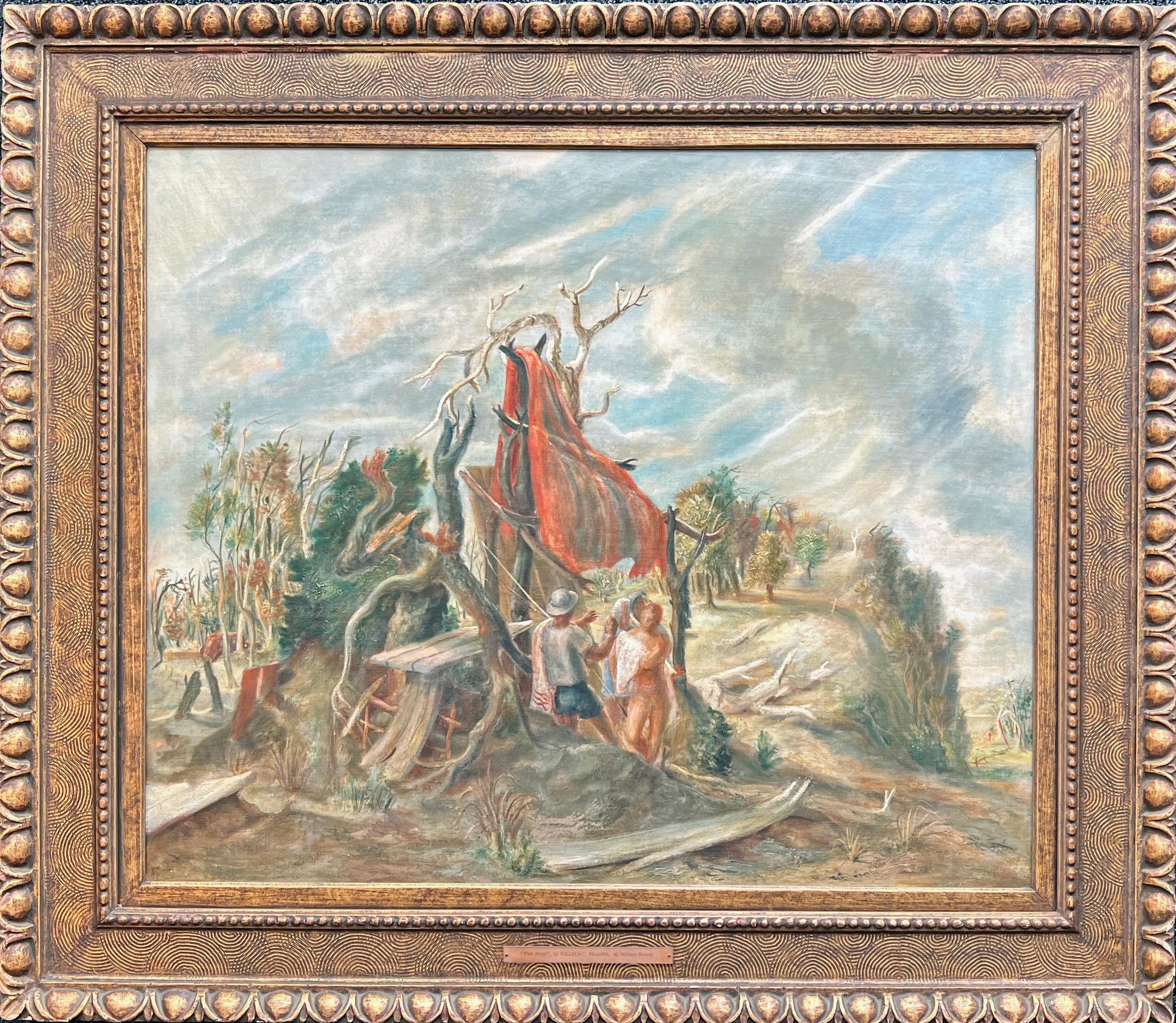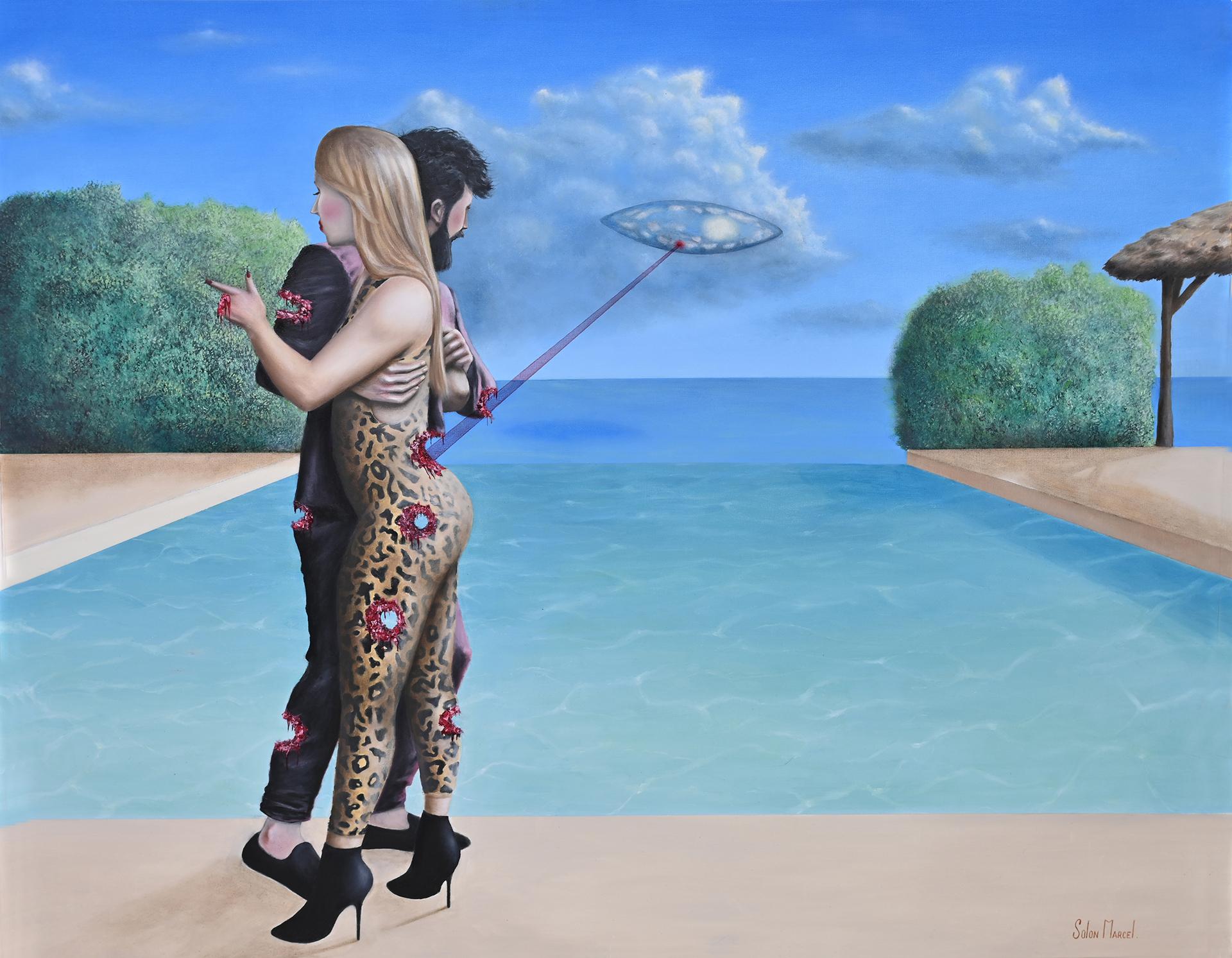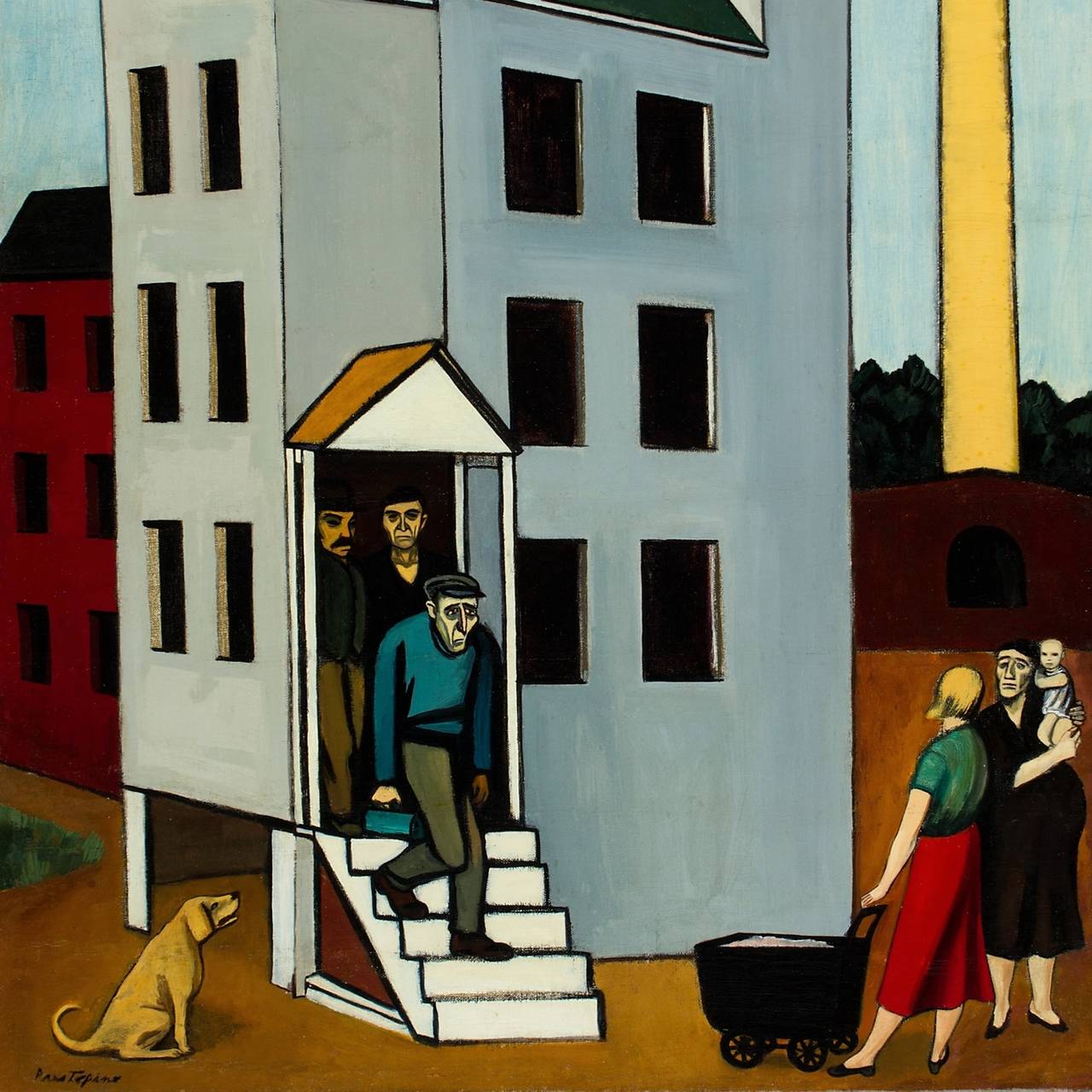Items Similar to Native American Figures at Taos Pueblo, New Mexico Southwestern Oil Painting
Video Loading
Want more images or videos?
Request additional images or videos from the seller
1 of 14
Native American Figures at Taos Pueblo, New Mexico Southwestern Oil Painting
About the Item
Original 20th century oil painting by Wolfgang Pogzeba (1936-1982) with Native American figures standing in bright blankets with adobe buildings in the background at Taos Pueblo, New Mexico. Presented in a custom hardwood frame, outer dimensions measure 24 ½ x 32 ¼ x 1 ½ inches. Image size is 6 ¼ x 24 ¼ inches.
Painting is clean and in good vintage condition - please contact us for a detail condition report.
Provenance: Estate of Wolfgang Pogzeba
About the Artist:
A native of Germany, Pogzeba immigrated with his family to the United States where they settled in Denver, Colorado in 1950. He attended the Colorado School of Mines where he studied engineering and earned a BA in Fine Arts as well as a Master's in Education from the University of Colorado.
He eventually settled in Taos, New Mexico where he continued to produce his own art as well as leading the restoration of the Church of San Francisco de Asis in Rancho de Taos.
Pogzeba's career was cut short when he perished in a plane accident near Taos in 1982.
- Attributed to:Wolfgang Pogzeba (1936 - 1982)
- Dimensions:Height: 25.75 in (65.41 cm)Width: 29.5 in (74.93 cm)Depth: 1.75 in (4.45 cm)
- Medium:
- Movement & Style:
- Period:
- Condition:very good vintage condition. Custom frame has recently been added.
- Gallery Location:Denver, CO
- Reference Number:
About the Seller
5.0
Platinum Seller
These expertly vetted sellers are 1stDibs' most experienced sellers and are rated highest by our customers.
Established in 1979
1stDibs seller since 2013
264 sales on 1stDibs
Typical response time: 5 hours
- ShippingRetrieving quote...Ships From: Denver, CO
- Return PolicyA return for this item may be initiated within 7 days of delivery.
More From This SellerView All
- City Park, Denver, Colorado, Large Semi Abstract Colorful Oil LandscapeBy Edward MarecakLocated in Denver, COLarge format oil painting on canvas of City Park in Denver, Colorado by 20th century Denver modernist, Edward Marecak. Semi-abstract park scene with various types of trees, figures, ...Category
20th Century American Modern Landscape Paintings
MaterialsOil, Canvas
- East Santa Cruz (California), Farm House with Storm Clouds Landscape PaintingBy Jon BlanchetteLocated in Denver, CO"East Santa Cruz (California)" is an oil on canvas board by Jon Blanchette (1908-1987) of a yellow farm house with dark gray storm clouds overhead. Presented in a custom frame, outer dimensions measure 21 ¾ x 25 ¾ x 1 ½ inches. Image size is 16 x 20 inches. Painting is in very good vintage condition - please contact us for a detailed condition report. Expedited and international shipping is available - please contact us for a quote. About the Artist: Jon Blanchette Born England, 1908 Died California, 1987 Jon Blanchette was born in Somerset, England on March 29, 1908. He immigrated to Battle Creek, Michigan in 1918. Artistically inclined at age six, he later studied at the Pittsburgh Art...Category
1950s American Modern Figurative Paintings
MaterialsCanvas, Oil, Board
- Adobe Church, New Mexico, 1940s Modernist Southwestern Landscape Oil PaintingBy Paul Kauvar SmithLocated in Denver, COVintage 1930s - 1940s oil painting of an adobe church in New Mexico with a brilliant blue sky and clouds (likely Rancho de Taos), circa 1940. Painted by Denver modernist, Paul K...Category
1940s American Modern Landscape Paintings
MaterialsCanvas, Oil
- Storm Over Victor (Colorado Mountain Town), 1940s WPA Era Landscape Oil PaintingLocated in Denver, COOil on board painting by George Vander Sluis (1915-1984) titled Storm Over Victor (Colorado Mountain Town) from 1946. WPA Era Mountain Landscape wi...Category
1940s American Modern Landscape Paintings
MaterialsOil, Board
- Near Watsonville, California, Mid Century Landscape Oil Painting House TreesBy Jon BlanchetteLocated in Denver, COMid 20th Century oil on artist board of a white house near Watsonville, California. 1950s landscape painting with house and trees. Presented in a...Category
Mid-20th Century American Modern Landscape Paintings
MaterialsOil, Board
- Autumn Harvest, Original Semi-Abstract Landscape and Figurative Oil PaintingBy Edward MarecakLocated in Denver, COOriginal framed oil painting on burlap by Edward Marecak (1919-1993) titled "Autumn Harvest" from 1987. Signed and dated by the artist in the lower right corner. Presented in a custom framed, outer dimensions measure 20 x 29 x 1 ⅜ inches. Image size is 19 x 28 inches. Provenance: Estate of the Artist, Edward Marecak Painting is clean and in good condition - please contact us for a detailed condition report. Expedited and international shipping is available - please contact us for a quote. About the artist: Born to immigrant parents from the Carpathian region in Slovakia, Marecak grew up with his family in the farming community of Bennett’s Corners, now part of the town of Brunswick, near Cleveland, Ohio. When he turned twelve, his family moved to a multi-ethnic neighborhood of Poles, Czechs, Slovaks, and Slovenians in Cleveland. His childhood household cherished the customs and Slavic folk tales from the Old Country that later strongly influenced his work as a professional artist. During junior high he painted scenery for puppet shows of “Peter and the Wolf,” awakening his interest in art. In his senior year in high school he did Cézanne-inspired watercolors of Ohio barns at seventy-five cents apiece for the National Youth Administration. They earned him a full scholarship to the Cleveland Institute of Art (1938-1942) where he studied with Henry George Keller whose work was included in the 1913 New York Armory Show. In 1940 Marecak also taught at the Museum School of the Cleveland Institute. Before being drafted into the military in 1942, he briefly attended the Cranbrook Academy of Art near Detroit, one of the nation’s leading graduate schools of art, architecture, and design. A center of innovative work in architecture, art and design with an educational approach built on a mentorship model, it has been home to some of the world’s most renowned designers and artists, including Eero Saarinen, Charles Eames, Daniel Libeskind and Harry Bertoia. Marecak’s studies at Cranbrook with painter Zoltan Sepeshy and sculptor Carl Milles were interrupted by U.S. army service in the Aleutian Islands during World War II. Following his military discharge, Marecak studied on the G.I. Bill at the Colorado Springs Fine Arts Center from 1946 to 1950, having previously met its director, Boardman Robinson, conducting a seminar in mural painting at the Cleveland Institute of Art. Although he did not work with Robinson at the Fine Arts Center, who had become quite ill - retiring in 1947 - he studied Robinson’s specialty of mural painting before leaving to briefly attend the Cranbrook Academy in 1947. That same year he returned to the Fine Arts Center, studying painting with Jean Charlot and Mary Chenoweth, and lithography with Lawrence Barrett with whom he produced some 132 images during 1948-49. At the Fine Arts Center he met his future wife, Donna Fortin, whom he married in 1947. Also a Midwesterner, she had taken night art courses at Hull House in Chicago, later studying at the Art Institute of Chicago with the encouragement of artist Edgar Britton. After World War II she studied with him from 1946 to 1949 at the Fine Arts Center. (He had moved to Colorado Springs to treat his tuberculosis.) Ed Marecak also became good friends with Britton, later collaborating with him on the design of large stained glass windows for a local church. In 1950-51 Marecak returned to the Cleveland Institute of Art to complete his Bachelor of Fine Arts degree. A year later he was invited to conduct a summer class at the University of Colorado in Boulder, confirming his interest in the teaching profession. In 1955 he received his teaching certificate from the University of Denver. Vance Kirkland, the head of its art department, helped him get a teaching job with the Denver Public Schools so that he and his family could remain in the Mile High City. For the next twenty-five years he taught art at Skinner, Grove, East, George Washington and Morey Junior High Schools. Prior to coming to Colorado, Marecak did watercolors resembling those of Winslow Homer, John Singer Sargent and Charles Burchfield. However, once in Colorado Springs he decided to destroy much of his earlier oeuvre, embarking on a totally new direction unlike anything he had previously done. Initially, in the 1940s, he was influenced by surrealist imagery and Paul Klee and in the West by Indian petroglyphs and Kachinas. His first one-person show at the Garrett Gallery in Colorado Springs in 1949 featured paintings and lithographs rendered in the style of Magic Realism and referential abstraction. The pieces, including an oil Witch with Pink Dish...Category
1980s American Modern Landscape Paintings
MaterialsOil
You May Also Like
- Six O'ClockLocated in Los Angeles, CASix O-Clock, c. 1942, oil on canvas, 30 x 20 inches, signed and titled several times verso of frame and stretcher (perhaps by another hand), marked “Rehn” several times on frame (for the Frank K. M. Rehn Galleries in New York City, who represented Craig at the time); Exhibited: 1) 18th Biennial Exhibition of Contemporary American Oil Paintings from March 21 to May 2, 1943 at The Corcoran Gallery of Art in Washington, D.C. #87, original price $450 (per catalog) (exhibition label verso), 2) Craig’s one-man show at the Frank K. M. Rehn Galleries, New York City, from October 26 to November 14, 1942, #10 (original price listed as $350); and 3) Exhibition of thirty paintings sponsored by the Harrisburg Art Association at the State Museum of Pennsylvania in Harrisburg in March, 1944 (concerning this exhibit, Penelope Redd of The Evening News (Harrisburg, Pennsylvania) wrote: “Other paintings that have overtones of superrealism inherent in the subjects include Tom Craig’s California nocturne, ‘Six O’Clock,’ two figures moving through the twilight . . . .” March 6, 1944, p. 13); another label verso from The Museum of Art of Toledo (Ohio): original frame: Provenance includes George Stern Gallery, Los Angeles, CA About the Painting Long before Chris Burden’s iconic installation outside of the Los Angeles County Museum of Art, Urban Light, another artist, Tom Craig, made Southern California streetlights the subject of one of his early 1940s paintings. Consisting of dozens of recycled streetlights from the 1920s and 1930s forming a classical colonnade at the museum’s entrance, Burden’s Urban Light has become a symbol of Los Angeles. For Burden, the streetlights represent what constitutes an advanced society, something “safe after dark and beautiful to behold.” It seems that Craig is playing on the same theme in Six O-Clock. Although we see two hunched figures trudging along the sidewalk at the end of a long day, the real stars of this painting are the streetlights which brighten the twilight and silhouette another iconic symbol of Los Angeles, the palm trees in the distance. Mountains in the background and the distant view of a suburban neighborhood join the streetlights and palm trees as classic subject matter for a California Scene painting, but Craig gives us a twist by depicting the scene not as a sun-drenched natural expanse. Rather, Craig uses thin layers of oil paint, mimicking the watercolor technique for which he is most famous, to show us the twinkling beauty of manmade light and the safety it affords. Although Southern California is a land of natural wonders, the interventions of humanity are already everywhere in Los Angeles and as one critic noted, the resulting painting has an air of “superrealism.” About the Artist Thomas Theodore Craig was a well-known fixture in the Southern California art scene. He was born in Upland California. Craig graduated with a degree in botany from Pomona College and studied painting at Pamona and the Chouinard Art School with Stanton MacDonald-Wright and Barse Miller among others. He became close friends with fellow artist Milford Zornes...Category
1940s American Modern Landscape Paintings
MaterialsCanvas, Oil
- Fish Story oil painting by Williams Charles PalmerLocated in Hudson, NYThis painting is illustrated in the Catalogue of the 1945 Encyclopedia Britannica Collection of Contemporary American Painting, p.84. Written and edited by Grace Pagano. "Painting ...Category
Mid-20th Century American Modern Figurative Paintings
MaterialsOil, Canvas
- Halleluja, A storyLocated in Greenwich, CTInitially read as archaic and simple, Halleluja is a complex celebratory spring painting full of color, imagination, and humor and combines many elements seen throughout her later ca...Category
1940s American Modern Figurative Paintings
MaterialsCanvas, Oil
- Intergalactic Bounty HunterLocated in New York, NY2023, Oil on canvasCategory
2010s American Modern Figurative Paintings
MaterialsCanvas, Oil
- "Little House Lambertville, Public Sale"By Joseph BarrettLocated in Lambertville, NJJim’s of Lambertville is proud to offer this artwork. Signed lower middle. Artist designed frame. Joseph Barrett (b. 1936) Joseph Barrett was born in Midland, North Carolina, in ...Category
20th Century American Modern Landscape Paintings
MaterialsCanvas, Oil
- The FactoryBy Gregorio PrestopinoLocated in Concord, MAGREGORIO PRESTOPINO (1907-1984) The Factory, c. 1935 Oil on canvas 30 x 24 inches Signed at lower left: Prestopino Born in the Little Italy section of New York City, Prestopino was awarded a scholarship to the National Academy of Design at the age of fourteen. Early in his career he came under the influence of the French Impressionists, but was soon drawn to the American realists of the Ashcan School, whose work led him directly to the study of urban life. As a young man Prestopino set up his first studio in Harlem. During the 1930s his social realist paintings had an anecdotal quality in their description of everyday incidents of the working class, depicting the grit of city life – docks, laborers, vendors, Lower East Side streets. Prestopino lived in Brooklyn for many years, spending summers at a farm near Clinton, New Jersey. At the farm Prestopino painted in the barn, while his wife - illustrator Elizabeth Dauber - had a studio in the house. He moved to Roosevelt, New Jersey in 1949. Other artists who have lived in Roosevelt include Ben and Bernarda Shahn, their son Jonathan Shahn, Jacob Landau, David Stone Martin and his son, Stefan Martin...Category
1930s American Modern Figurative Paintings
MaterialsCanvas, Oil
Recently Viewed
View AllMore Ways To Browse
Mid Modern American Paintings
Southwestern Art
Taos Painting
Taos Mexico
Taos New Mexico
Taos New Mexico Art
American 20th Century Colorado
Southwestern Paintings
Original Oil Painting With Church
Southwestern Native American
Vintage Paintings Mexico
Midcentury Modern Mexican Painting
Mid Century Mexico Oil
Oil Paintings Germany 1950
Frames Southwestern Art
Tao Vintage
Taos Oil
Taos Oil Painting





